Last year, the concept of web3 took the minds of digital entrepreneurs and venture capitalists by storm. The idea is to build a new version of the web that incorporates concepts such as decentralization, smart contracts, and blockchain technologies. Web3 and blockchain technologies have also enabled the new blockchain domain naming services and a new type of domain name – a blockchain domain name. Blockchain domains have spurred a legal tightrope as these domain names are outside of ICANN’s jurisdiction and are not directly subject to any DNS-related laws and regulations that are in place to protect brand owners.
One of the most critical legal implications of blockchain domain names is enforcing a brand owner’s rights. The emergence of blockchain domain names gives rise to ‘cybersquatting 2.0’, or even ‘cybersquatting 3.0’ (analogous to web3).
Cybersquatting is a decades-old term that refers to the unauthorized registration and use of traditional Internet domain names that are identical to trademarks, company names, or personal names. In web3, a new blockchain-based web, cybersquatting stays the same, but it happens with blockchain domain names instead of the traditional domain names. Just as we saw in the 1990s, squatters are actively gobbling up blockchain domain names that contain famous trademarks. Already this year, there were several cybersquatting lawsuits related to the registration of the web3 domains in the U.S. Due to the technological changes in the world of domain names, it has become increasingly important to understand cybersquatting 3.0 and prevent blockchain domain name infringement.
First, let's briefly examine the architecture and design of traditional domain names. Second, we will take a look at the emerging blockchain domain standards and provide a comparison of the two types of domains based on a number of criteria. Third, we will analyze the legal implications and potential challenges that the new type of domains may bring about, including such areas as cybersquatting, name collisions, and jurisdiction.
Architecture of Traditional Domain Names
To understand the architecture of traditional domain names, let’s briefly review the unique nature of IP addresses and their role in the development of the Internet.
Imagine a computer network in its simplest configuration with your computer and your friend’s computers connected by a wire so that you can play games together. The network between two computers is an example of a local network. The Internet, as a system, consists of multiple similarly interconnected computer networks of devices, or hosts. However, unlike computers on a local network, computers on the Internet interact not directly but through intermediaries, such as Internet service providers (ISP),network infrastructure providers, and others.
In the very beginning, the Internet started with two large networks in the United States – the military network, ARPANET and the scientists’ network, NSFNet. As new networks appeared around the world, in order to connect them and enable their stable functioning, standards (or protocols) governing their interaction were developed. The key protocols that set rules governing the communication of various networks and hosts are the Transmission Control Protocol (TCP) and the Internet Protocol (IP). TCP/IP uses the client-server model of communication in which a computer (client) is provided a service, like sending a webpage, by another computer (a server). To enable sending data from one device to another and communicating with other devices, an IP address, a unique identifier of a device connected to the Internet, is used.
The organization that coordinates IP addresses of sites and devices is the Internet Corporation for Assigned Names and Numbers (ICANN), a non-profit organization registered in California, USA. The ICANN includes various organizations from all regions of the world, including Regional Internet Registers (RIR) – 5 non-profit organizations that distribute the IP address space. In other words, they give out IP addresses.
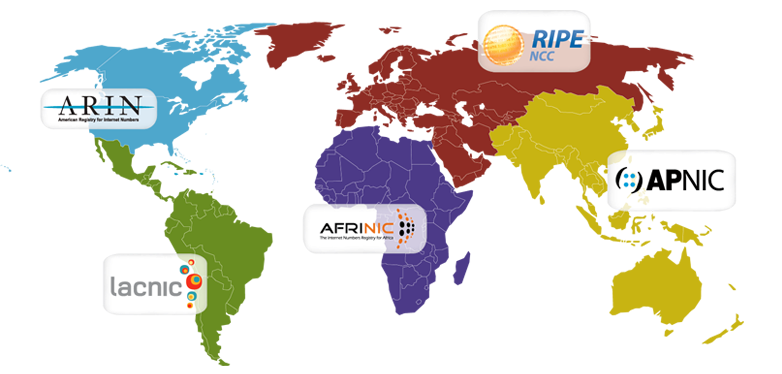
The IP address is usually written in decimal digits. For example, if you type the IP address 142.251.46.174 in the browser search bar, you will be taken to the corresponding host – “google.com.” By the way, the example IP address is an IPv4 address. The IPv4 address space includes 4 billion 294 million 967 thousand 296 combinations. Does that seem like a lot? In fact, all IPv4 addresses have already been taken. Therefore, the IPv4 protocol has been replaced by the IPv6 protocol. The IPv6 address space supports a total of 79 octillion addresses (79 228 162 514 264 337 593 543 950 336 addresses). An IP address under the IPv6 protocol looks like this: FF80:0000:0000:0000:0123:1234:ABCD:EF12.
Obviously, it is hard to remember a bunch of numeric addresses of all websites. For the convenience of Internet users, navigation on the Internet using domain names, or names in a lateral and easily readable format that are linked to numeric IP addresses, were invented. To enable the use of lateral domain names, a unified system that “translates” a domain name into an IP address was created – the Domain Name System (DNS). The system allows you to access a host (computer, server, or even a “smart light bulb”) not by an IP address but by a human-readable domain name. For example, if you type “google.com” into a web browser, the DNS server behind the scenes maps that name to the corresponding numeric IP address 142.251.46.174 (or another, as Google has several of them).
DNS is a hierarchical decentralized system for naming devices on the Internet, whose operations are supported by a large number of organizations and individuals. The organization that maintains the registers of unique Internet identifiers, including domain names and IP addresses, is the Internet Assigned Numbers Authority (IANA), an ICANN department. IANA also coordinates DNS operations by delegating top-level domain (TLD) management to its operators.
How DNS works
When a user types a domain name into the search bar, the browser first checks the local DNS cache for the correct resolution to translate a domain name into an IP address, and, if no corresponding IP is found in the local computer cache, the request goes to a “recursive resolver.” Most often, it is the recursive DNS server managed by the Internet service provider (ISP). If the “recursive resolver” does not have any information, the request from the ISP server follows the authoritative hierarchy of DNS servers:
- The first request goes to the DNS Root Zone, which is managed by IANA and lists the names and addresses for all top-level domains (TLDs) such as “.com,” “.org,” “.net,” “.cn,” “.de” and so on. The servers that serve the DNS Root Zone are a network of hundreds of servers in many countries around the world. They are operated by 13 independent authorities. If the corresponding IP address is not found in the cache within the root zone, the letters after “.” designate the root servers where it can find information about the domain name and redirect the request to appropriate TLD servers.
- The second request goes to a TLD server, which is managed by registry operators. There are over 1000 TLDs covering domains from “.abb” to “.zw.” DNS TLD servers receive domain information from domain registrars, such as GoDaddy.
- The third request goes to an authoritative DNS server to find a second-level domain. For example, in “google.com”, “google” is the second-level domain, and ".com” is the top-level domain. Second-level domains are delegated by the operators assigned by IANA. For example, VeriSignGlobal Registry Services operates the authoritative registries “.com” and “.net”. The authoritative DNS servers are giving responses to queries just for the zones they are configured, which usually is where the web hosting company or the DNS provider is located.
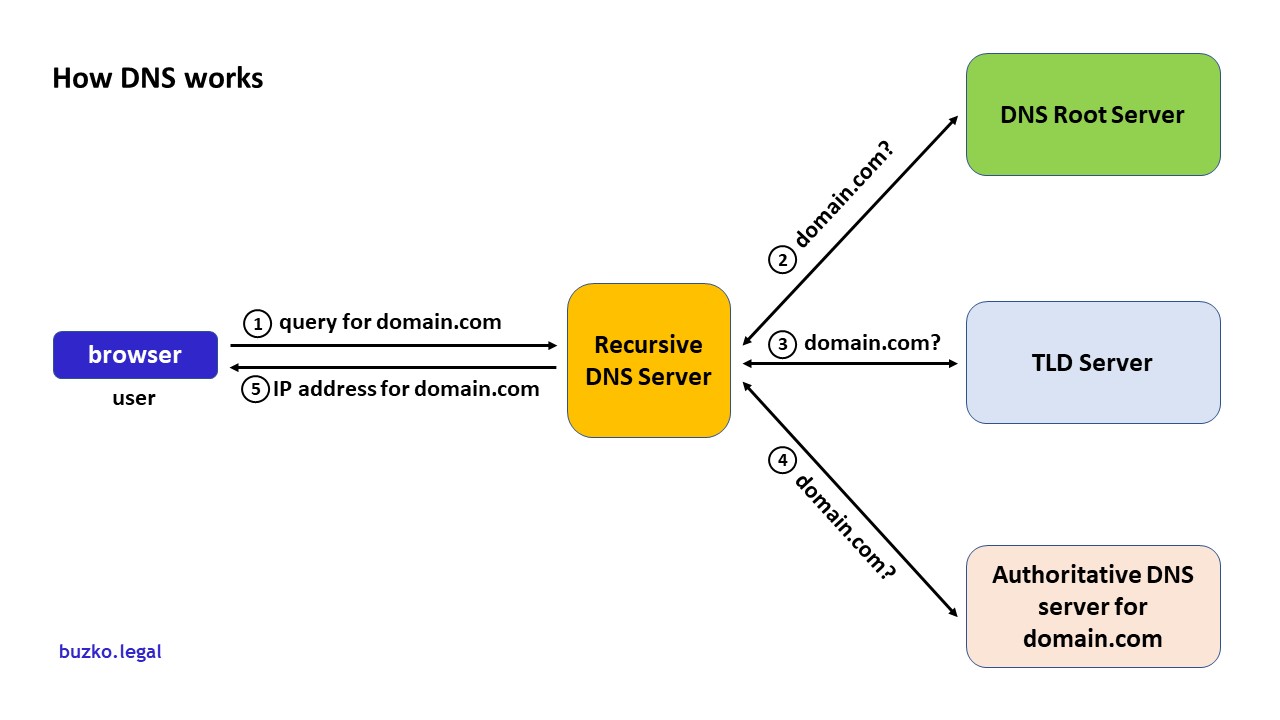
Once the DNS finds the IP address associated with the domain name, it sends the relevant information to your computer, and your browser loads the website.
To get a more detailed and visual idea of how DNS converts a domain name into an IP address, check out this helpful comic.
To summarize, a traditional domain name is a host’s identifier in human-readable format linked to a unique IP address. Using traditional domain names would be impossible without the DNS, a hierarchically organized system that finds a host by translating a domain name into an IP address. The functioning of the DNS is supported by multiple organizations from different regions and states, each of which may try to promote and defend its own interests. Moreover, on October 1, 2016, the contract for performing IANA’s functions, including management of the DNS Root Zone, between ICANN and the National Telecommunications and Information Administration (NTIA) of the US Department of Commerce officially expired. This means that today, the DNS is controlled by a private body without any affiliation with the US government.
Emerging Blockchain Domain Names
Blockchain is a continuous sequential chain of blocks (a linked list) containing information built according to certain rules. A blockchain can be compared with a database where a set of users work together in creating a unified network. But unlike a traditional centralized database, which is stored in a single location, a blockchain is a decentralized system where each participant, or a node (computer), has a copy of all records.
Each block in a blockchain contains a timestamp, transaction data, and a cryptographic hash of the previous block. Since each block contains information about the previous block, they form a chain, with each additional block linking to the previous ones. Therefore, blockchains are resistant to modification of their data because once recorded, the data in any block cannot be altered without altering all subsequent blocks. If any of the blocks were changed, the change would be detected immediately because the computed hash no longer matches the original hash – and the block would not pass validation.
The core components of the blockchain are the nodes that enable the operation of the system. The term “node” means not any device within the system but only the ones that validate and store the complete history of transactions. Anyone can set up a node by downloading the blockchain protocol software onto their personal computer anywhere in the world. For example, all miners are nodes because they confirm transactions according to the same rules and software.
Usually, all nodes together form a peer-to-peer network, where each node holds a copy of the blockchain, and the exchange of data occurs without a central server. The blockchain network can be compared to a program, the functioning of which is provided by multiple nodes rather than a centralized server. Anyone can “connect to the network”, that is, contact one of the nodes and get information from the blockchain or perform a transaction.
On the Ethereum blockchain, each wallet (account) has a unique 42-character address, which looks like this: 0x5F327F5ECD396813577344E6710C0D16626f1aE6. The Ethereum address is the public address needed to send a token to this address, transfer funds, or issue any permission through a smart contract. To access funds and permissions in the address, the owner must know its private key.
Just like an IP address described earlier, the wallet address is too long and inconvenient to use. But are there any analogs to DNS domains in a lateral and easily readable format on the blockchain? Luckily, yes. For example, the Ethereum Name Service (ENS), a blockchain naming service, allows to register a human-readable “.eth” domain, e.g. “buzkokrasnov.eth”, and map it to the associated machine-readable wallet address 0x5F327F5ECD396813577344E6710C0D16626f1aE6.
The technology of mapping ENS domains with wallet addresses is actively being introduced into the world of web3. Even Etherscan, the most popular search engine that lets users look up, confirm and validate transactions on the Ethereum blockchain, has enabled the search of a wallet by an ENS domain name (you can find statistics on the creation of ENS names here). Another major company that supports the implementation of blockchain domains is Opera, the developer of the Opera browser. They integrated with another blockchain domain name service, Unstoppable Domains, which provides users with popular “.crypto” domains (though, ENS domains also seem to work fine in Opera).
How does ENS work
To understand how ENS works, let’s first understand what it is made of. Essentially, ENS includes two Ethereum smart contracts or programs stored on the blockchain that run when predetermined conditions are met:
- The ENS registry, a smart contract, which maintains a list of all domains and subdomains, including the information about: (i) the domain owner and their blockchain address, (ii) resolver, and (iii) a cache lifetime for all domain records (time-to-live).
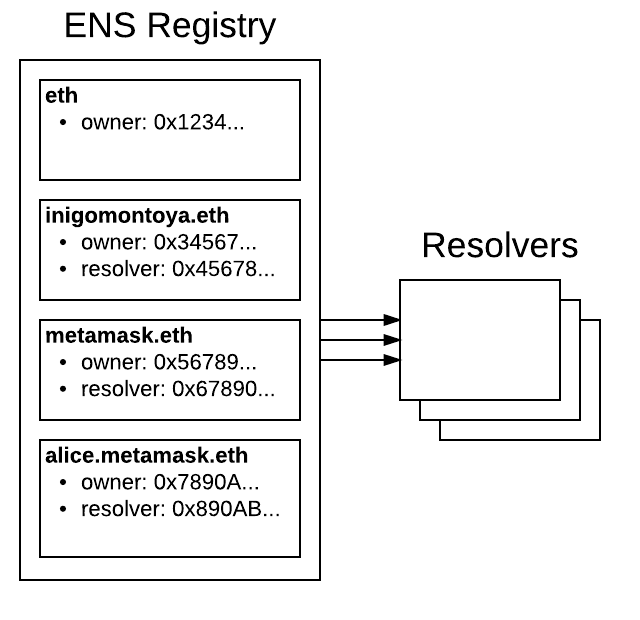
- The Resolver, a smart contract that converts a domain name, such as “domain.eth,” to a machine-readable wallet address, also provides other information about the domain. You can write your own resolver but it must comply with the ENS standards. In the DNS, the resolver is usually your Internet service provider (see the comic if you missed it).
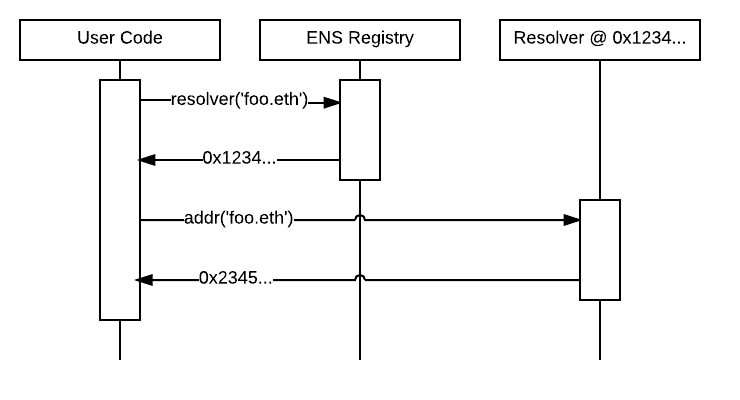
In fact, the ENS works much like a lookup service, similar to the way the DNS works. First, a request is sent to the ENS registry to obtain the address of the resolver. Then, a second request is sent to the resolver to obtain information about the domain.
Thus, the ENS is a blockchain equivalent of the commonly used Domain Name System (DNS). Both of them translate human-readable names into their underlying representations – an IP address or a wallet address.
Perhaps the main difference, in addition to the technical aspects and management of the systems, is the information that is contained in the registries. The DNS records contain information about the domain and IP address of the devices, such as information about the server and where the website is hosted. The ENS registry contains information about the web3 domains and wallet addresses, as well as any other information at the discretion of the domain owner, such as a profile on GitHub or Twitter. The ENS domain also can be linked to the IPFS websites and DNS domains.
Overall, web2 and web3 domains perform the same function in that they allow finding addresses by human-readable domain names - and not by a set of meaningless characters. Perhaps in the future, systems like ENS may replace DNS, and then the differences between them will completely vanish.
Today, ENS has already registered a huge number of domains that are the names of large brands, companies, or famous people. There is a high chance that these domains are tricks of cybersquatters. Thus, the differences between naming systems across web2 and web3 are important for determining the possibility of applying existing laws on DNS domains to web3 domains.
Difference Between DNS and ENS
The table below summarizes the key differences between DNS and ENS domains based on eight characteristics.

Legal Aspects of Blockchain Domain Names
Currently, the two largest blockchain domain naming services are Ethereum Name Service (ENS), offering domains with the top level domain “.eth,” and Unstoppable Domains, offering domains with such top level domains as “.crypto,” “.nft,” and “.bitcoin.” Let’s analyze the legal implications and potential challenges that the new type of domains may bring about.
Does ICANN Have Any Authority over Blockchain Domain Names?
ICANN is a nonprofit organization and its authority to provide its functions derives from a contract with the National Telecommunications and Information Administration of the Department of Commerce (NTIA) of the United States. The latest version of this contract was awarded to ICANN in July 2012 for 7 years and it officially expired in 2016.
Under the latest contract with NTIA, ICANN is placed at the top of the traditional global domain name system and is in charge of the distribution and coordination of the Domain Name System (DNS) and IP addresses.
Blockchain domain names are not recognized by ICANN because they are not part of DNS hierarchy. The blockchain domains do not fall under ICANN’s authority under the latest contract with NTIA. Moreover, the websites of ENS and Unstoppable Domains also state in their governance documentation that the respective blockchain domain systems are not part of the current DNS. Moreover, ICANN does not have the technical ability to influence blockchain domains.
Thus, none of the Internet-related regulatory bodies have authority over blockchain domains.
Are Blockchain Domain Names Recognized as Domain Names under Existing Law?
A definition of the term ‘domain name’ is given in the Anticybersquatting Consumer Protection Act (ACPA): A domain name is an “alphanumeric designation which is registered with or assigned by any domain name registrar, domain name registry, or other domain name registration authority as part of an electronic address on the Internet”.
Let’s review the meaning of these terms from the definition to find out whether the definition of the term ‘domain name’ is applicable to web3 domains:
- an alphanumeric designation;
- a domain name registrar, domain name registry, or other domain name registration authority as part of an electronic address on the Internet; and
- the Internet.
‘An alphanumeric designation’ ✅
Both DNS domain names and ENS domain names are alphanumeric designations. Also, they both consist of TLD and 2LD.
With regards to the DNS naming hierarchy, the ICANN in the Glossary section of its website defines TLDs as the names at the top of the hierarchy. They appear in domain names as the string of letters following the last “.”, such as “net” in “www.example.net”. The second-level domain of the DNS is the string of letters before the last “.”, such as “example” in “www.example.net’.
On the other hand, with regards to the ENS naming hierarchy, the ENS website states that ENS operates “ENS-specific TLDs,” which are restricted to only “.eth” and “.test”, plus any special purpose TLDs.
Thus, the ENS domain name, or other blockchain domain name, seems to fit the definition of the domain name, and definitions of TLDs and 2LDs are also applicable with the proviso that these terms apply in two different infrastructures: the Internet and blockchain.
‘A domain name registrar, registry, or other registration authority’✅
ACPA does not describe these terms. However, these concepts can be found in what we discussed earlier – from DNS regulations. Thus, the ICANN in the Glossary section at its website gives the following definitions:
- Domain name registrar – a company that registers domains and is included in the Accredited Registrar Directory, e.g.,, GoDaddy;
- Domain name registry – a domain name directory, e.g.,, a Root zone registry or a second-level domain registry .com; and
- Other domain name registration authority – apparently, it can be any other entity involved in the operation of the Internet, such as an organization supporting the email addresses service or any other auxiliary resource / server.
In ENS, a domain name registrar is a smart contract responsible for allocating subdomains, and the registry is the core contract of ENS that maintains a mapping from domain name to owner, resolver, and time-to-live.
Again, both ENS and DNS domain name services have a domain name registrar, registry, or other registration authority; however, their nature is different: smart contracts and companies.
‘The Internet’ vs Blockchain ❓
We can easily draw an analogy from ENS to DNS when discussing the terms above; however, with the concept of the Internet, it is a bit more complicated.
ACPA refers to the domain name as an alphanumeric designation on the Internet while the ENS domain seems to be an electronic address on the blockchain.
ACPA describes the term ‘Internet’ as “the international computer network of both Federal and non-Federal interoperable packet switched data networks”. Obviously, blockchain does not really fall under this category.
However, there are two interpretations of the ENS domain:
- ENS domain is an identifier to use in the blockchain only; or
- ENS domain is not only an identifier of a wallet in the blockchain but also an Internet address because accessing the blockchain is not possible without the Internet. Moreover, the ENS domain name can be linked not only to a wallet but also to social networks or to a website.
Under the first approach, ACPA clearly cannot be applied to ENS and other web3 domains. However when viewing these domains under the second approach, ACPA seems to be applicable to them. Let's look into these concepts in further detail.
First Approach
As stated above, under ACPA, the Internet is an international computer network of both federal and non-federal interoperable packet switched data networks.
Thus, not any computer network is the Internet, but only an interoperable packet switched data network. This specification is crucial, for example, the Ethereum blockchain network is a peer-to-peer network. Therefore, technically, the Ethereum network is not a packet switched data network (although this is debatable). This means, that:
- the Ethereum network cannot be equated with a network that is part of the Internet;
- the Ethereum network cannot be equated with “the Internet”, because, as the term is defined by ACPA, “the Internet” is a network of many networks, and the Ethereum network is a single network – a network of nodes; and
- accordingly, the ENS domain is an address on the blockchain and not on the Internet.
Second Approach
Regardless of what is stated above, access to the blockchain network and the blockchain itself is available only with the use of the Internet. Having access to the Internet, anyone can get information from the blockchain.
The network itself can be compared to an application that operates in a decentralized way, with copies of its data available on each node, rather than on a single server. By referring to a blockchain wallet by its domain name, we are actually referring to such a decentralized application over the Internet.
Therefore, the Internet and the blockchain network correlate as general and particular. Under the second, an extended interpretation, it turns out that we use the ENS domain to access an address on the Internet, which is located in one of the applications that work using the Internet.
Literally, the second interpretation of the term ‘blockchain domain’, as an address on the application accessible through the Internet, corresponds to the term domain name under ACPA.
But with this approach, we can say that any identifier, nickname, or login in any online application or game is a domain name, because it maps the user's number in the database with his or her login.
However, these identifiers have a different nature, purpose, and meaning on the Internet. Maybe, this is not so obvious now, but blockchains with their financial and other tools are more important and interoperable (compatible) than logins in an online game. Moreover, using a web3 domain we can access a decentralized website on IPFS, and then the line between the traditional domain and blockchain domain is completely blurred. For example, Opera already supports some web3 domains linked to IPFS.
Originally, no one could have imagined that domain names would become so valuable on the Internet, but before that, the Internet itself was also not taken seriously. It is likely that the role of web3 domains will be the same as the role of DNS domains, and, after some time, we will be able to see either new laws in this area or additions to ACPA.
From a legal perspective, the introduction of blockchain domain names, in a time when DNS has been operated for decades and multiple DAOs launch their own TLDs simultaneously, creates the potential for two legal issues: cybersquatting and name collision. As ACPA does not bind the term “domain name'' to DNS only, the infringements on blockchain domain names should be viewed under the existing cybersquatting laws and naming convention regulations.
Protection from Cybersquatters in the World of DNS Domains
Cybersquatting is a registration of domain names containing a trademark or brand name of another person for the purpose of resale or unfair use.
There are several ways to be protected from cybersquatting. First, ICANN developed a number of mechanisms that enable trademark holders to protect their rights during the DNS expansion. Second, the legislation of many countries allows the cancellation of the registration of domains that violate IP rights.
ICANN Mechanisms for Protecting the Rights of the Trademark Holders
1. Unified Domain Name Dispute Resolution Policy (UDRP)
The policy has been adopted by ICANN for resolving disputes arising between the domain-name owner and any other party over the registration and use of an Internet domain name such as in the case of cybersquatting. It establishes the procedure of the expedited administrative proceedings initiated by the trademark or service mark owner or someone who has legitimate interests in the domain name by filing a complaint with an approved dispute-resolution service provider.
This procedure applies only to gTLD domains.
Managers of country-code top-level domains (ccTLDs) join the policy on a voluntary basis.
2. Post-Delegation Dispute Resolution Procedures (PDDRP)
The procedures provide the trademark holder with the opportunity to file a claim against new gTLD registry operators who intentionally make a profit in bad faith by systematically registering domain names in violation of the rights of trademark owners. Various legal remedies are provided under this procedure, including the termination of a Registry Agreement.
3. Early Registration (the Sunrise Period)
Before a new top-level domain (gTLD) launches, such as “.com”, a Sunrise period takes place. This is a special period during which trademark holders are given the opportunity to preregister domain names that are the same or similar to their trademarks. This occurs before registration of the TLD becomes open to the general public. Every new gTLD is required to organize a sunrise period. Here you can view the dates that reflect this period for specific TLDs.
4. Uniform Rapid Suspension (URS)
URS is a fast and effective mechanism that allows the trademark owners to file a complaint and, as a result, suspend a registered domain name in clear cases of infringement. A determination to suspend or not to suspend the domain name is taken by the certified examiners. All gTLD registry operators are required to comply with the determinations resulting from URS proceedings.
5. Trademark Clearinghouse
The Trademark Clearinghouse is a global repository for trademark data - the first of its kind in the domain name space. The Trademark Clearinghouse is maintained for the purpose of protecting brands in ICANN’s new gTLDs. The Trademark Clearinghouse is strictly for second-level domain names. Rights holders who register their marks with the Trademark Clearinghouse must still register with their country’s trademark office.
6. Trademark Claims
During the Trademark Claims period (90 days), anyone attempting to register a domain name that matches a mark that is recorded in the Trademark Clearinghouse will receive a real-time notification displaying the relevant trademark information. If the notified party goes ahead and registers the domain name, the Trademark Clearinghouse will send a notice to the registered trademark holders. This procedure applies to all new gTLDs.
Legal Mechanisms for the Cancellation of Domain Name that Infringes the Rights of the Trademark Holders
First of all, the mechanisms for the cancellation of a domain name that infringes the rights of the trademark holders can be found in the intellectual property laws. In many jurisdictions, IP laws provide the trademark owners and even brand-owners without a registered trademark with a procedure to challenge the domain registration that infringes their rights through the courts.
Secondly, some jurisdictions have special laws on bad-faith trademark registration (cybersquatting).
In the US, the law that is aimed at protecting trademark owners from cybersquatters, as discussed earlier, is the Anticybersquatting Consumer Protection Act (ACPA). The law applies to the cases of cybersquatting only when someone intentionally registers a domain name identical or similar to a particular trademark in order to gain some kind of benefit such as parasitizing on someone else’s fame or reselling the domain. In other cases, ACPA does not apply, but the right holders can still prove through the court the illegal use of the trademark as a domain name and register the domain themselves by relying on the trademark law.
Next, we will review the two important problems with web3 domain registration, cybersquatting, and name collision, under the current laws in the United States.
Protection from Cybersquatting in the World of Web3 Domains
There is no legislation on cybersquatting and other related web3 domain name disputes. But even if there were laws, there is no possibility of a forced domain take over, since everything in the world of web3 is built on smart contracts. However, technically, a smart contract can provide an option of a forced domain take over under certain conditions.
ICANN also doesn’t have any power over blockchain domain names, and any standard UDRP dispute would fail for lack of jurisdiction.
As there are no laws on blockchain domain name registration and use, let’s take a look into the regulations and policies developed by the two most popular services for blockchain domain name registration: Unstoppable Domains and ENS.
Unstoppable Domains Regulations on Cybersquatting
Compared to ENS, this naming service seems to be more friendly towards trademark holders.
The service has developed Protected Brands Policy (Sunrise), which defines a "sunrise period”, a procedure similar to ICANN’s Sunrise Period mechanism. Unstoppable Domains guarantees to protect trademarks registered with the United States Patent and Trademark Office (USPTO) and provide a period (“sunrise period”) during which trademarked domains of the most famous brands cannot be registered by anyone other than their owners.
A distinctive feature of the service is that the domain is purchased once and you do not need to renew it. Therefore, the sunrise period is especially important. The latest update to the policy states that the sunrise period with respect to currently available top-level domains ended on April 19, 2022.
However, the Unstoppable Domains service designates “protected domains”. Protected domains are domains that the service detected is associated with a brand, organization, or notable person.
For example, if you search “apple.crypto”, the service will show that the domain is “Protected.” If you are a trademark or brand owner interested in applying for a Protected domain, you may submit a Protected Brands Form even after the end of the sunrise period.

The Terms of Use of Unstoppable Domains state that a customer shall not violate or infringe the rights of others, including intellectual property or other proprietary rights.
The service reserves the right to refuse to sell any domain listed at its sole discretion, as well as cancel domains purchased with a full refund in case of trademark infringement, phishing, or other misuses.
It is important to mention that the domain registration can be canceled only if the user has not yet “minted” the domain, meaning they have not yet created an NFT with it (this is done through the service interface after purchase).
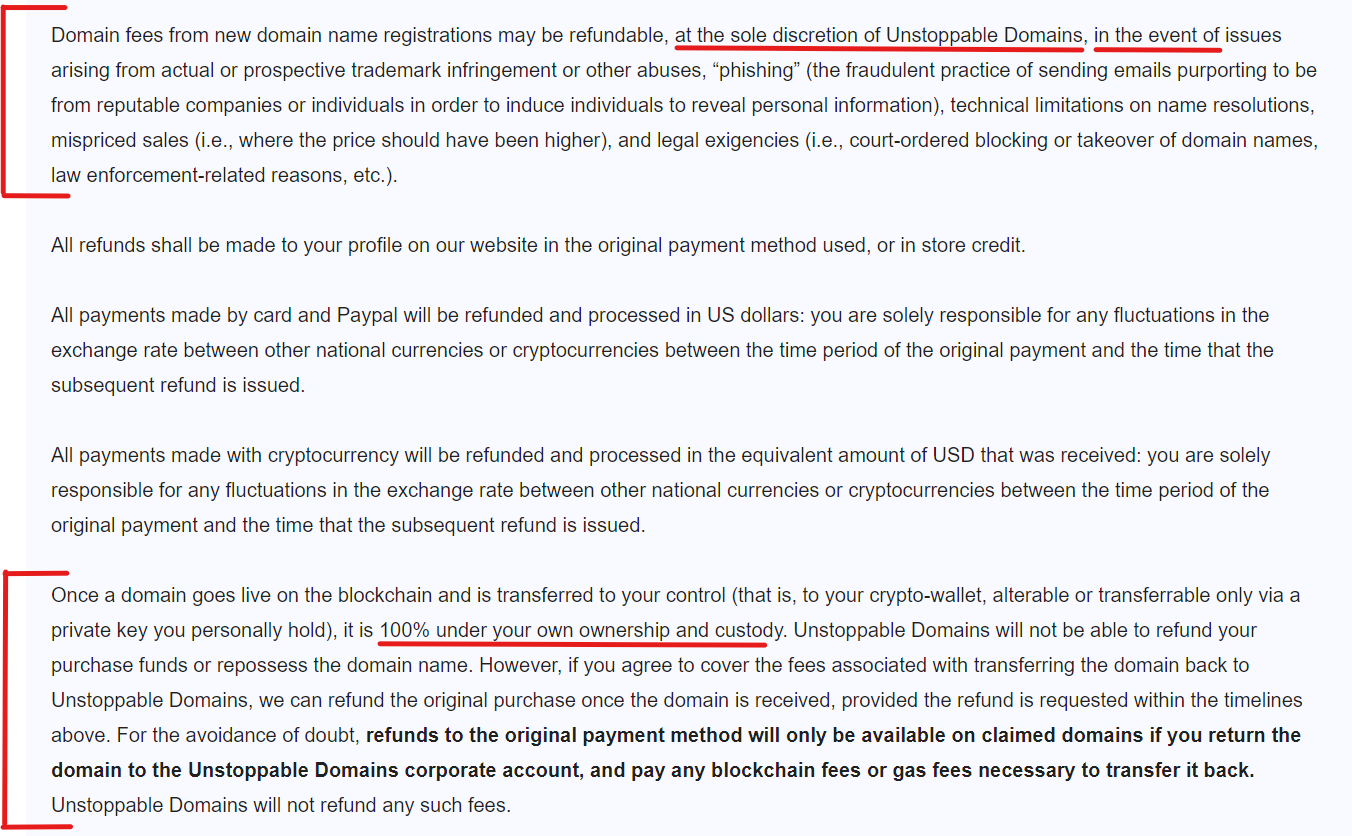
Ethereum Name Service (ENS) Regulations on Cybersquatting
ENS seems to be a more radical and decentralized service in terms of respect for the rights of trademark holders. Below are a few quotes from the discussions section on the ENS website:
- ENS is not going to turn into ICANN;
- Many of ENS’s replies underline that ENS is a decentralized system and everyone has the right to buy any domain. There are attempts to argue that registering an ENS domain that is someone else’s brand is not a violation (examples: here and here); and
- The ".eth” name may be released to the “rightful owner” if the domain owner is willing to release that name, for example, because he believes that ENS is the foundational stone for web3, and releasing the domain helps grow adoption, and is altruistic.
While ENS does not limit anyone to what they can do with their “.eth” names, certain technical measures to protect trademark owners against cybersquatters were done in the design of the ENS protocol. You can read about them here. These mechanisms are not ideal and, rather, are aimed at making cybersquatting more complicated.
ENS DAO, a member-owned system without centralized leadership that manages ENS, has developed its short constitution. Its first article immediately suggests certain conclusions:
I. Name ownership shall not be infringed
ENS governance will not enact any change that infringes on the rights of ENS users to retain names they own, or unfairly discriminate against name owners’ ability to extend, transfer, or otherwise use their names.
OpenSea and Cybersquatting
ENS and Unstoppable Domains allows anyone to mint a unique domain name as NFT. These NFTs can be sold, and the popular OpenSea platform is often used for this.
OpenSea, at the request of the rightsholder, can withdraw the token from sale in case of the alleged infringement of the trademark rights or other intellectual property rights. It is supposed that because of this policy, the cybersquatter will not be able to benefit from the domain and will only suffer losses in connection with domain renewal. Note that in ENS domains need to be renewed; however, domains do not have to be renewed in Unstoppable Domains.
Not everyone agrees with the OpenSea view on protection against cybersquatting, thus, there are many of those who express their disagreement with OpenSea policy through the messages on the forums and support the idea of a decentralized exchange for the sale of NFT.
Identifying an Infringer on the Blockchain
Imagine that you decided to protect your rights by filing a traditional lawsuit. But who is the defendant? The owner of the blockchain domain name is anonymous and did not provide any information when registering the domain name.
Pseudonymity
It is thought that users in the blockchain are completely anonymous. This is partially true because sometimes it is possible to identify the wallet owner (domain owner) by some traces.
The easiest and most effective way to identify the owner is to find an account on a centralized exchange or on a service for buying crypto from which the wallet was replenished.
For example, this service allows viewing wallet transactions in a convenient way and identifying related accounts.
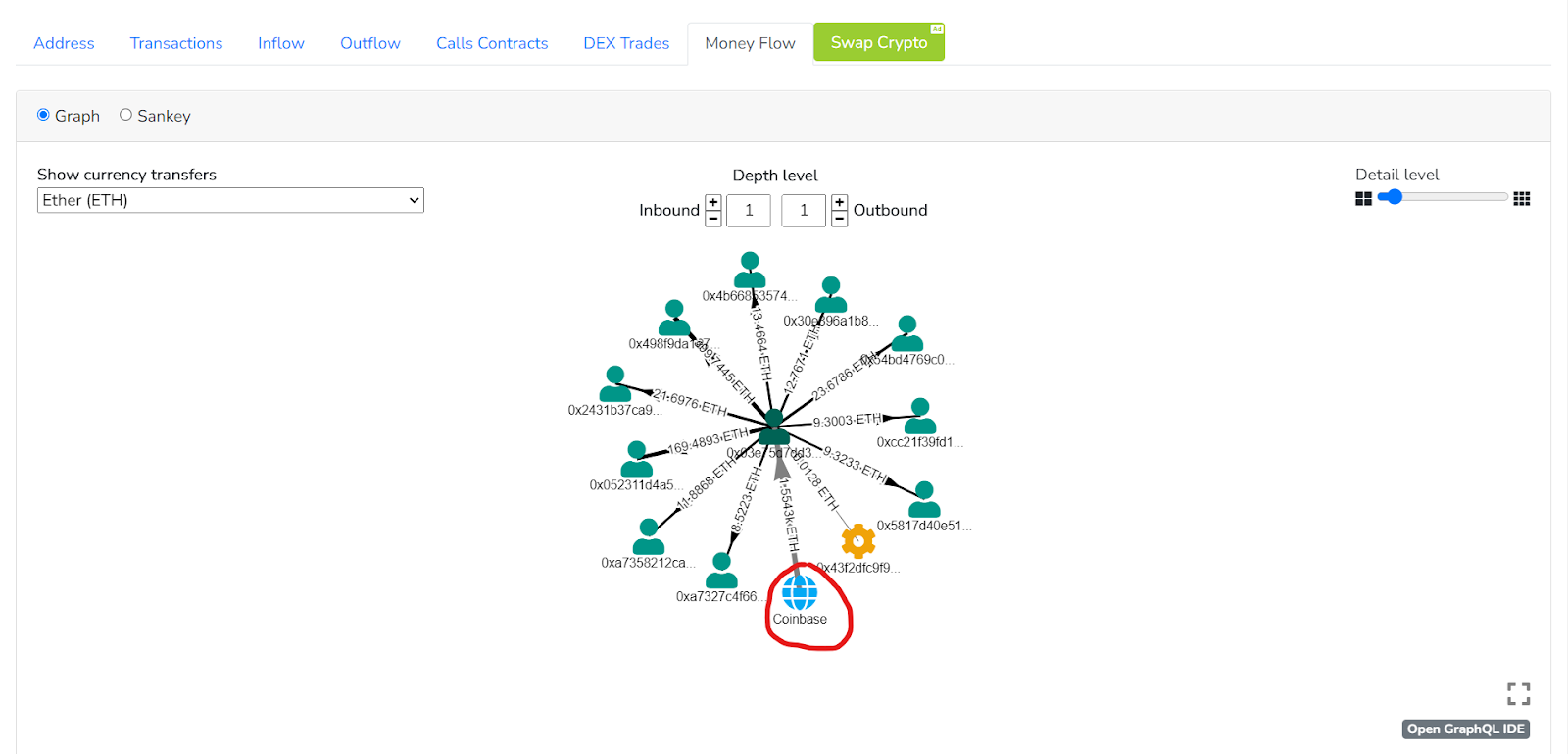
The screenshot above shows that a transaction was made on the Coinbase exchange (for this example, a random address on Ethereum was used). If the owner of the address was a cybersquatter, we could request information from Coinbase about the account owner in order to contact him and send a claim or lawsuit. Of course, Coinbase will not disclose information about its users; however, this may be possible pursuant to an order from a court.
There may be other traces. For example, if an owner has shown his wallet address somewhere publicly: in chats, forums, and so on. It’s not that straightforward, but it is possible.
If a Cybersquatter is Anonymous and Cannot be Identified
In general, there are two scenarios when a court in the United States has the authority to review a cybersquatting claim:
- A lawsuit is filed against a squatter who resides, maintains connections, or is served notice of legal proceedings in the USA (in personam jurisdiction). However, if the identity of the squatter is unknown and there is no information about his location, we need to find another basis for the court’s jurisdiction.
- A lawsuit concerns a dispute about the ownership of a specific piece of property, such as a domain name (in rem jurisdiction). Under ACPA, a lawsuit can be filed only over the domain itself, when: (i) registrar, (ii) registry, or (iii) other domain name authority is located in the USA.
The second option is not always applicable to domains in the blockchain because organizations managing domain names may be registered outside the United States or may not have a legal entity at all. Also, blockchain technology implies the absence of centralized servers; therefore, it cannot be said that the registry of names is located in the United States.
What a Trademark Owner Can Do
Unstoppable Domains
According to the website, the service is operated by Unstoppable Domains Inc.
To register a protected brand domain, fill out the form to get in touch with the service.
To contact the service on issues of intellectual property rights infringements, you can email them at legal@unstoppabledomains.com.
Also, the service allows paying for the domain not only by cryptocurrencies, but offers traditional payment methods, as well as registration via email. It also makes sense to first contact the administration of the service to get information about the infringer.
ENS
The service was started by the Ethereum Foundation in early 2017. In 2018, a Singapore-based non-profit organization True Names LTD, was launched to lead and support the development and standardization of the ENS (perhaps, this company today coordinates the development of the project).
Currently, the ENS protocol is managed by the ENS DAO, whose interests are represented in the brick and mortar world by a Cayman Islands Foundation.
Given the great decentralization of the system, it seems that it will be more complicated to get assistance from ENS. Today, you can contact the team directly or through the Discord community.
Sending a Message to a Wallet Address
NFT as a Legal Way to Serve Court Documents
Recently LCX (lcx.com), a company incorporated in Liechtenstein, filed a lawsuit with the Supreme Court of the State of New York against a “John Doe Nos. 1-25.” The plaintiff stated in its complaint that defendants John Doe Nos. 1-25 are persons of unknown citizenship.
In January 2022, the unknown defendants accessed the LCX Exchange digital wallet and transferred the stolen crypto assets to an Ethereum address under their control.
LCX’s counsel asked the court to serve notice of the court proceedings by means of an NFT using the public keys to the wallets of the defendants.
The Court ruled that a special purpose Ethereum-based token (NFT), or “the Service Token”, can be used to serve a copy of the order, together with other papers under New York State laws.
The Service Token should contain a link to a website created by the plaintiff, where the materials of the case are published. The link should also contain a mechanism to track when a person clicks the link. This is ambiguous, but still a solution.
In the United Kingdom, there was an analogous court decision at almost the same time (June 2022). The High Court of England and Wales in one of the recent cases granted an order permitting service of court proceedings via the transfer of a token on the blockchain. You can find more details here.
Blockscan Chat
Blockscan Chat allows users to instantly message each other wallet-to-wallet or ENS domain-to-domain. The platform is integrated with Etherscan.

Blockspan Chat works outside of the blockchain network. The only thing that connects the platform with Ethereum is authorization with a wallet and the ability to send a message to anyone just by knowing the specific wallet or ENS domain.
If you send a complaint through Blockspan Chat, will the wallet owner receive it? We cannot be certain, but it’s worth a try. If the wallet owner has used the chat before, and turned on notifications, then they are likely to open a message. Moreover, the service is integrated with Etherscan, which is known to almost all Ethereum users and even displays an indicator of unread messages.
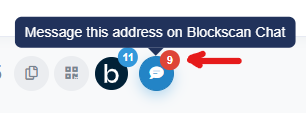
How to Send a Message in the Blockchain
Another way to send a message in the blockchain is by hiding it in a transaction, for example, as here.
But a person may realize that there was an incoming message in a transaction only if he knows about this method of communication; otherwise, the message can go unnoticed.
Comments on Etherscan
You can also leave a message in the comments section on Etherscan. Hopefully, the owner of the wallet will read it someday.
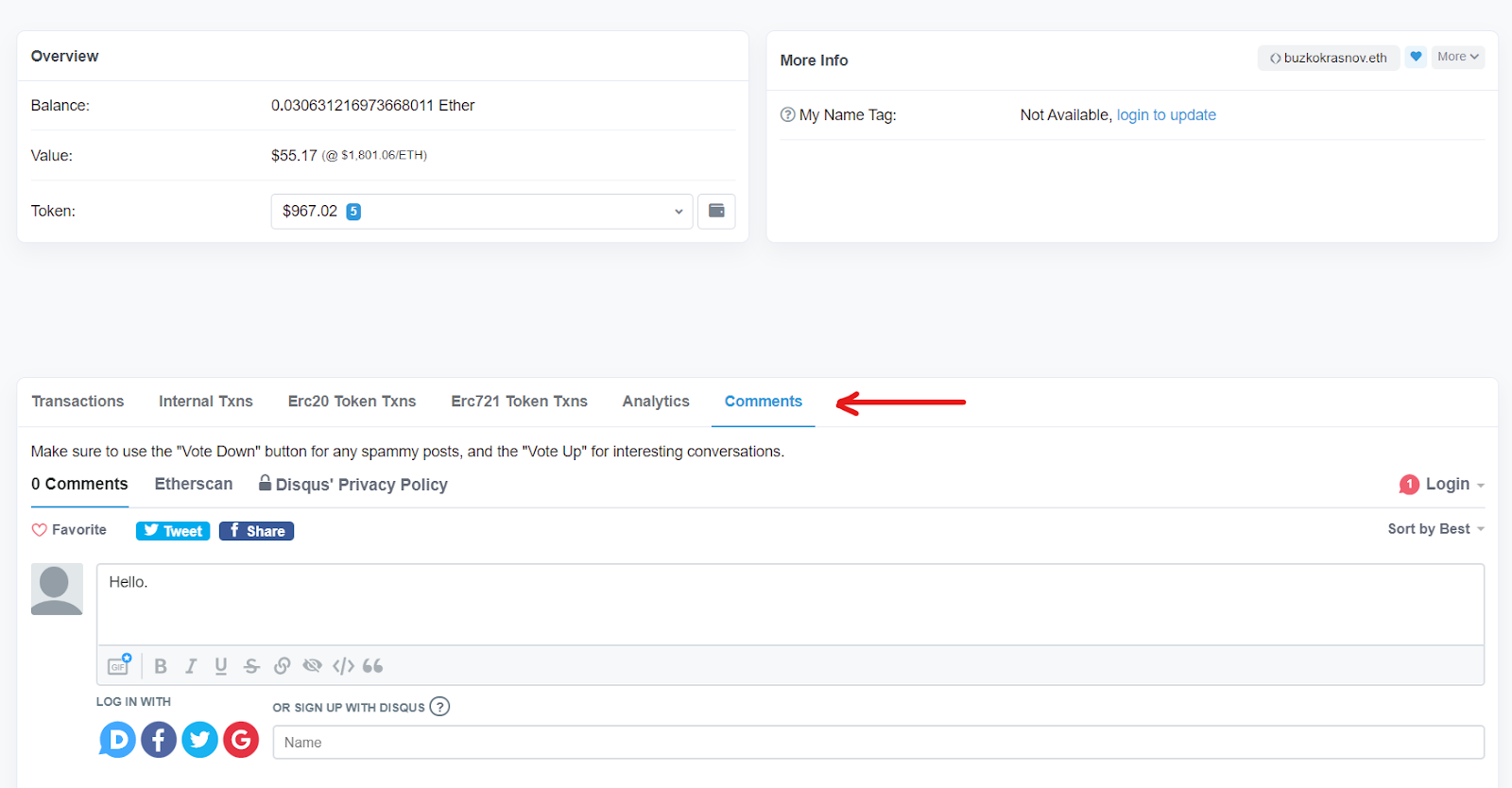
Name Collisions
In addition to the issues of cybersquatting, one of the most common problems in the world of blockchain domains is name collisions. Recently, the largest domain name service – Unstoppable Domains – filed a lawsuit against another registrar Gateway.io. Now, let’s get into the details of name collisions.
Is There Any Authoritative Hierarchy of Domain Naming Services on the Blockchain ?
As discussed earlier, in DNS, the authoritative hierarchy includes: the Root Zone, which lists the names for all top-level domains (TLDs) and is managed by IANA; TLDs from “.abb” to “.zw.”, managed by registry operators; and, second-level domains managed by the operators assigned by IANA.
Thus, management of the traditional domain namespace is somewhat centralized, and its critical component – the Root Zone – is managed by IANA (part of ICANN).
What About the Distribution of Blockchain Name Space?
The blockchain is an ideal mechanism for achieving a global consensus on ownership and recording the transfer of ownership rights to domain names. However, some problems, such as agreement on namespace allocation, cannot be solved with blockchain technologies.
Today, there are many web3 domain naming services: Unstoppable Domains, ENS, Blockstack, Gateway, and others, each of which offers to buy a second-level blockchain domain name. With more domain naming services, the allocation of naming space is becoming more complex. Obviously, some rules are needed.
The main question is which blockchain solution will take on the role of ICANN in distributing the blockchain TLDs in the Root Zone.
The most prominent project in this field is Handshake. The project intends to become an intermediary, similar to ICANN, and create a decentralized network to enable a global allocation of names. Even though it seems that the project is trying to centralize web3, this is not true. Handshake operates by providing a decentralized lookup of name records over decentralized networks without any intermediaries. Moreover, since its foundation in 2010, Handshake has developed many unique authenticated structures to enable domain names distribution which make the system more advanced compared to other naming services, such as ENS or Blockstack.
Nevertheless, Handshake’s role in the hierarchy of the blockchain naming systems is not official and is not unanimously recognized by the community. There are no rules, smart contracts, or other solutions to control the distribution of TLDs on the blockchain. This lack of coordination has given rise to a recent lawsuit filed by Unstoppable Domains against Gateway.io.
Battle of Naming Services: Unstoppable Domains vs Gateway.io
Unstoppable Domains is a blockchain name service that has been managing the “.wallet” domain since June 2021 and has sold hundreds of thousands of these domain names to its customers in just over a year.
Gateway is a blockchain name service that started to sell popular “.wallet” domains to its customers a year later - in 2022. Gateway.io is a company that acts as a registry and registrar for Handshake domain names.
Unstoppable Domains sent a cease and desist letter to Gateway demanding that they stop selling “.wallet” domains.
However, as we know, the blockchain network is decentralized, and one of its main principles is that no single participant controls any part of the network. Thus, any restrictions and regulations contradict the purpose of using blockchain to build a free Internet. No one, including Unstoppable Domains, can claim the right to control any part of the blockchain system.
Gateway also wholeheartedly supports the idea of free Internet, as is apparent from their comment on the situation with this tweet:

The gamechanger is the fact that Unstoppable Domains has filed the “.wallet” trademark with the U.S. Patent and Trademark Office. Subsequently, they submitted a lawsuit against Gateway claiming trademark infringement. They also stated that the existence of the defendants’ infringing “.wallet” domains causes the technical collision.
Gateway.io has slopped behind the cloud curtain and no longer accepts registrations for domains. It appears as if they have stopped their business after the lawsuit was filed.
Even though Unstoppable Domains won the battle by shutting down their competition, they remain in an unstable position. Its trademark application for “.wallet” is an intent-to-use trademark application. Additionally Unstoppable Domains has made other attempts to trademark top-level domains but has been declined by the U.S. Patent and Trademark Office because it does not grant trademarks for top-level domains.
This case points to an ongoing issue with alt-root blockchain domain names: name collisions.
ICANN and Name Collisions
If people can own a “.wallet” address in Unstoppable Domains and Handshake, there will be confusion between the two domains. A dispute between blockchain domain name owners is a preview of what’s to come.
ICANN is also concerned with blockchain-based systems and non-DNS names. There was a bit of discussion about blockchain-based domains at ICANN in 2022. The concern is that the lack of namespace coordination between alternative naming systems and the DNS may result in name collisions. The ICANN defines a name collision as “the situation where a name that is defined and used in one namespace also appears in another. Users and applications intending to use a name in one namespace may attempt to use it in a different one, and unexpected behavior may result where the intended use of the name is not the same in both namespaces. The circumstances that lead to a name collision could be accidental or malicious.”
However, there are non-blockchain-based alternative naming systems already in use, such as the Handle System and the Onion System, that have existed for a long time but have remained insignificant. The Onion System (Tor’s project) was introduced in 2004. In 2015, the Internet Engineering Task Force (IETF) designated “.onion” domains as ‘special-use domain names’, giving the system an official status.
Internet Engineering Task Force is another non-profit Internet related-regulatory body that develops a wide range of Internet standards dealing in particular with technical documents that influence the way people design, use and manage the Internet.
The IETF has not added “.eth,” or “.crypto” to any special-use domain name lists. Possibly, their status will be defined differently.
Conversely, Unstoppable Domains’ top-level domains may also be contested in the next round of applications when ICANN launches its next round of top-level domain names. As provided by ICANN, any established public or private organization that meets eligibility requirements anywhere in the world can apply to create and operate a new gTLD Registry.
Overall, none of the Internet related-regulatory bodies have authority over the blockchain domains. Today, there seems to be little possibility for the blockchain-based naming services and DNS to enter into an agreement as the blockchain-based naming services are governed by the Decentralized Autonomous Organization, a member-owned system without centralized leadership, and it is not clear who the contracting parties are. Nevertheless, the increasing number of name collisions may accelerate the development of new regulations and legal practices in this area.
* * *
The article was prepared by Buzko Krasnov lawyers Vasily Agateev, Kseniya Karchenko, Roman Buzko and Filipp Petkevitch. We have been advising on crypto since 2017. For questions, email at crypto@buzko.legal. Sign up to our Web3 Newsletter below to be notified of any web3 legal updates.